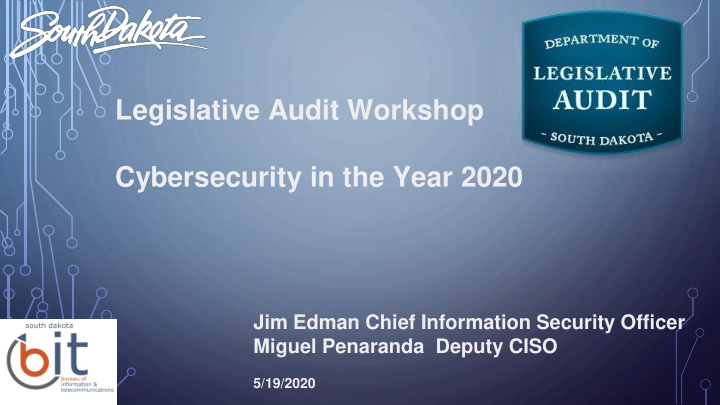



Legislative Audit Workshop Cybersecurity in the Year 2020 Jim Edman Chief Information Security Officer Miguel Penaranda Deputy CISO 5/19/2020
Critical Cyber Security Recommendations Backup Your Data Apply Automatic Updates & Patches • Decouple from live system after backup • Windows, Adobe, Java, • Test Restoring It Business Apps Education & Training • Cybersecurity class User Level privileges • Business Email Compromise • Remote Work
CYBERSECURITY COMPROMISE EXAMPLES • Texas School District $2.3M (Vendor Impersonation) • City of Baltimore, MD (3) $18.2M ($76K ask - Ransomware) • City of Atlanta, GA $17M ($25K ask - Ransomware) • 22 Texas Counties $12M ($2.5M ask - Ransomware) • City of Sioux Falls $??? (Vendor Impersonation) • Yankton, SD School District (Malicious) • SD School Teacher (Direct Deposit) • Iowa Retirement Benefits Fraud (Direct Deposit)
Not all security is social engineering or complicated software hacks.
Millions of Email Messages 549 Total Processed 88 107 Blocked Email 16 310 Quarantined Email 36 18 Outbound Email 9 114 Inbound Email 28 0 100 200 300 400 500 600 K-12 State CYBERSECURITY STATS
A denial-of-service attack is a cyber-attack in which the cyber threat actor seeks to make an Internet server or website unavailable to its users by temporarily or indefinitely disrupting services. A digital “traffic jam”. CYBERSECURITY STATS
CYBERSECURITY STATS
Types of Threat Actors Advanced • Nation State funded threat actors. China, Iran, North Korea, Persistence Threat Russia • Groups and individuals that either target or utilize opportunistic Cybercriminals methods based on system vulnerabilities • Hackers for hire; typically motivated by financial gain Criminal Hackers • Identity theft and healthcare fraud are their main targets • Politically driven groups and individuals Terrorists • Utilize target or opportunistic methods with system vulnerabilities • Malcontents Employees • Spies
Types of Attacks Social Credential Phishing Ransomware Engineering Harvesting Denial of Application Supply Physical Service Attacks Chain Security Attacks Insider Virus & Resource Destruction Threat Malware Usage
RANSOMWARE A type of malicious software designed to block access to a computer system until a sum of money is paid. Common names of ransomware: Bad Rabbit CryptoLocker CrytpoWall Ryuk WannaCry
Cybersecurity Infrastructure
Average amount time hackers are in a network before being discovered: 206 Days
Business Email Compromise Scams Account Vendor Payroll Direct Credentials Wire Transfer Impersonation Deposit (Username & Request password) Real Vendor Purchase Estate/Escrow Malware Delivery Gift Cards Order request Fund Transfer ……………………………………
Could this happen in SD? RECONNAISSANCE ➢ Open.SD.Gov: Vendors, $$$, Dates, Contracts, Contacts ➢ Internet: Employer Identification Number (EIN), SSNs ➢ Identify State employees: Online phone book, news, web sites ENGAGEMENT ➢ Email exchanges ➢ “Can you help me?” ACTION ➢ Update Systems ➢ Process Invoices, Payroll, etc. ➢ Divert Payments, Direct Deposits, etc.
5.4% Statewide 5.4% Statewide Average Average
Email Assessment
CRITICAL EMAIL STEPS 1. Reading is Fundamental 2. Look at the From: Name 3. Look at the From: Email Address. Name AND Address. 4. Subject: Familiar? 5. Message a. Spelling, Grammar & Content b. Don’t be swayed by branding c. Hover over links d. Attachments 5. Computer vs Mobile 6. Junk Mail Options
K-12 Cybersecurity Risk Assessment • Based on industry standard CIS Top 20 Controls
9 8 8 SCHOOL 8 ASSESSMENT 7 6 6 PERFORMANCE 5 4 3 3 3 2 1 0 A B C D F
K-12 Cybersecurity Incidents: 840 (2016)
Critical Cyber Security Recommendations Backup Your Data Apply Automatic Updates & Patches • Decouple from live system after backup • Windows, Adobe, Java, • Test Restoring It Business Apps Education & Training • Cybersecurity class User Level privileges • Business Email Compromise • Remote Work
Recommend
More recommend